QAC020C154S: System Analysis and Design - Library Report
VerifiedAdded on 2023/03/21
|12
|1756
|52
Report
AI Summary
This report provides a system analysis and design for a digital library management system, focusing on the Workington council's new library. It begins with an introduction to system analysis, emphasizing the use of UML diagrams for effective decomposition and analysis. The core of the report details the system design, starting with a use case diagram illustrating interactions between library administrators, students, and staff. It then presents a conceptual class diagram outlining the system's features, such as user registration, book availability checks, and employee details. The report includes an evaluation, confirming the project's scope achievement and comparing design choices with industry practices. The conclusion highlights the usefulness of a digital management system in improving library operations and the effectiveness of UML diagrams in simplifying complex processes. References to relevant books, journals, and online resources are also provided.
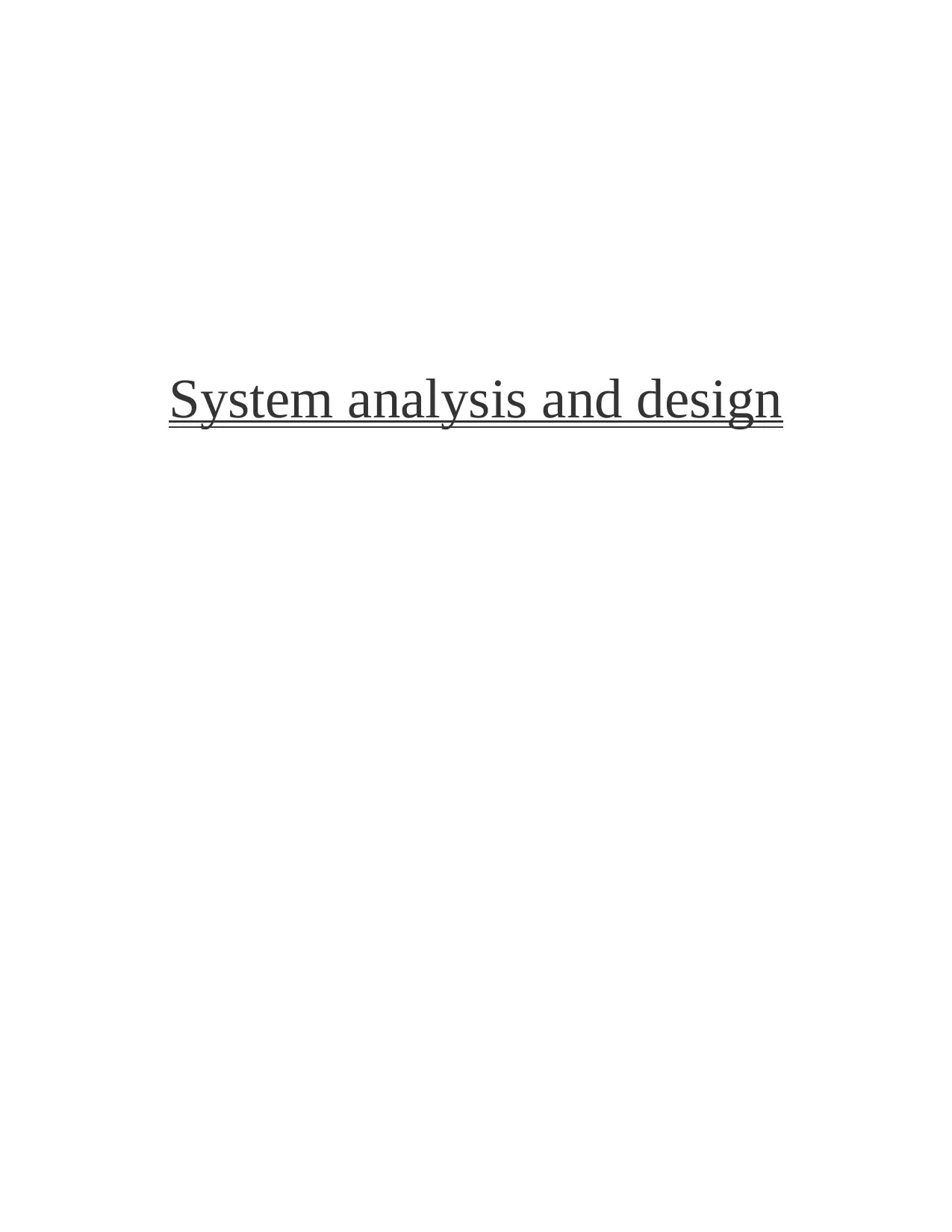
System analysis and design
Paraphrase This Document
Need a fresh take? Get an instant paraphrase of this document with our AI Paraphraser
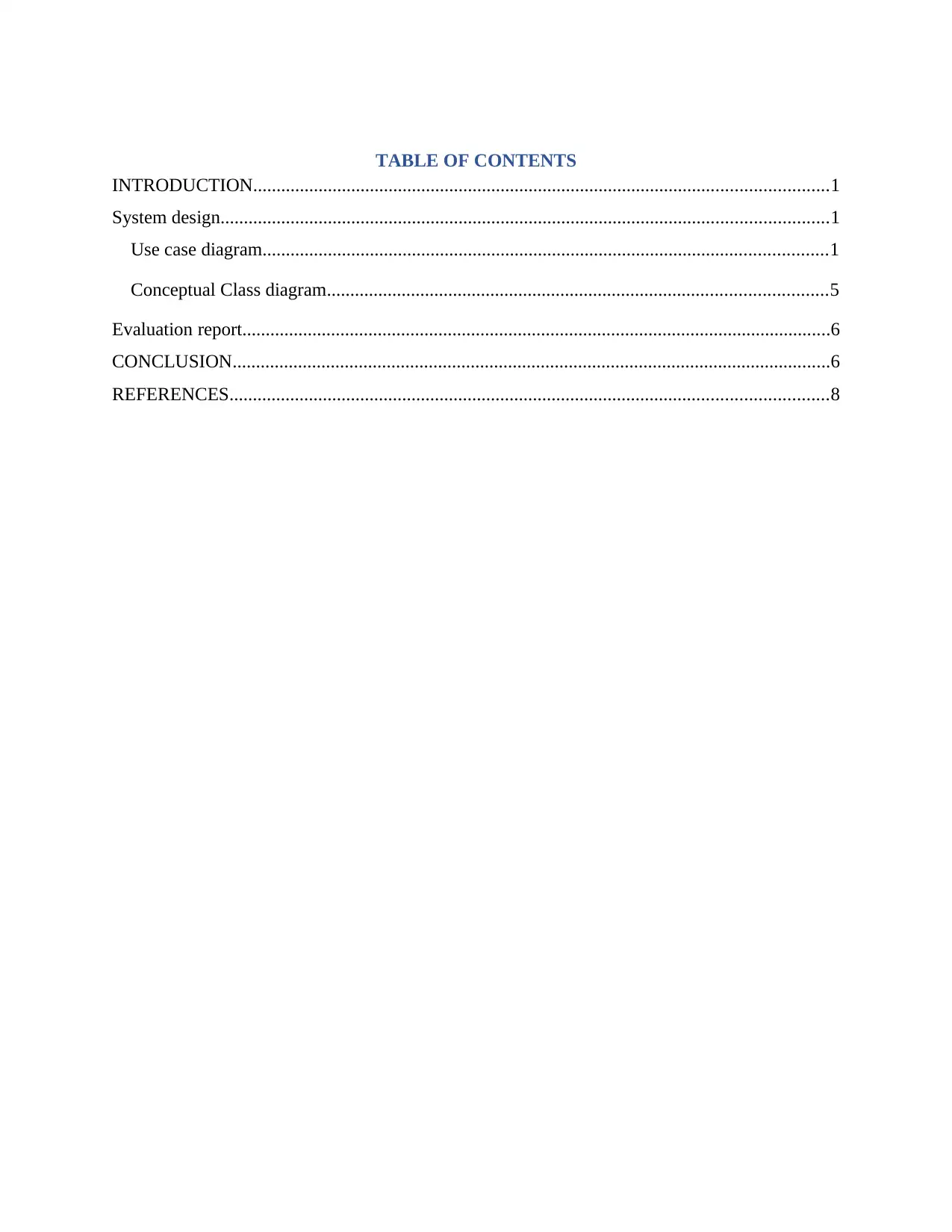
TABLE OF CONTENTS
INTRODUCTION...........................................................................................................................1
System design..................................................................................................................................1
Use case diagram.........................................................................................................................1
Conceptual Class diagram...........................................................................................................5
Evaluation report..............................................................................................................................6
CONCLUSION................................................................................................................................6
REFERENCES................................................................................................................................8
INTRODUCTION...........................................................................................................................1
System design..................................................................................................................................1
Use case diagram.........................................................................................................................1
Conceptual Class diagram...........................................................................................................5
Evaluation report..............................................................................................................................6
CONCLUSION................................................................................................................................6
REFERENCES................................................................................................................................8
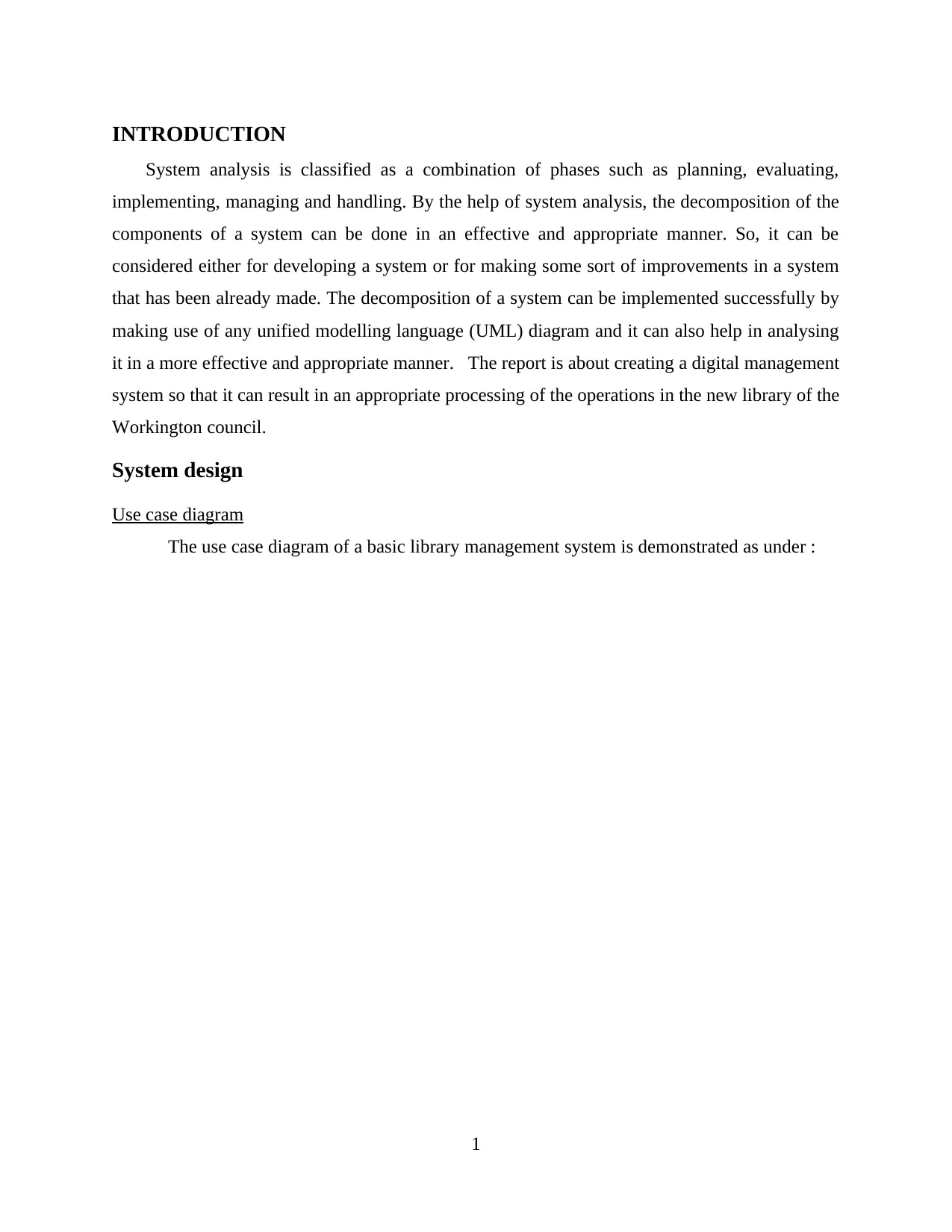
INTRODUCTION
System analysis is classified as a combination of phases such as planning, evaluating,
implementing, managing and handling. By the help of system analysis, the decomposition of the
components of a system can be done in an effective and appropriate manner. So, it can be
considered either for developing a system or for making some sort of improvements in a system
that has been already made. The decomposition of a system can be implemented successfully by
making use of any unified modelling language (UML) diagram and it can also help in analysing
it in a more effective and appropriate manner. The report is about creating a digital management
system so that it can result in an appropriate processing of the operations in the new library of the
Workington council.
System design
Use case diagram
The use case diagram of a basic library management system is demonstrated as under :
1
System analysis is classified as a combination of phases such as planning, evaluating,
implementing, managing and handling. By the help of system analysis, the decomposition of the
components of a system can be done in an effective and appropriate manner. So, it can be
considered either for developing a system or for making some sort of improvements in a system
that has been already made. The decomposition of a system can be implemented successfully by
making use of any unified modelling language (UML) diagram and it can also help in analysing
it in a more effective and appropriate manner. The report is about creating a digital management
system so that it can result in an appropriate processing of the operations in the new library of the
Workington council.
System design
Use case diagram
The use case diagram of a basic library management system is demonstrated as under :
1
⊘ This is a preview!⊘
Do you want full access?
Subscribe today to unlock all pages.

Trusted by 1+ million students worldwide
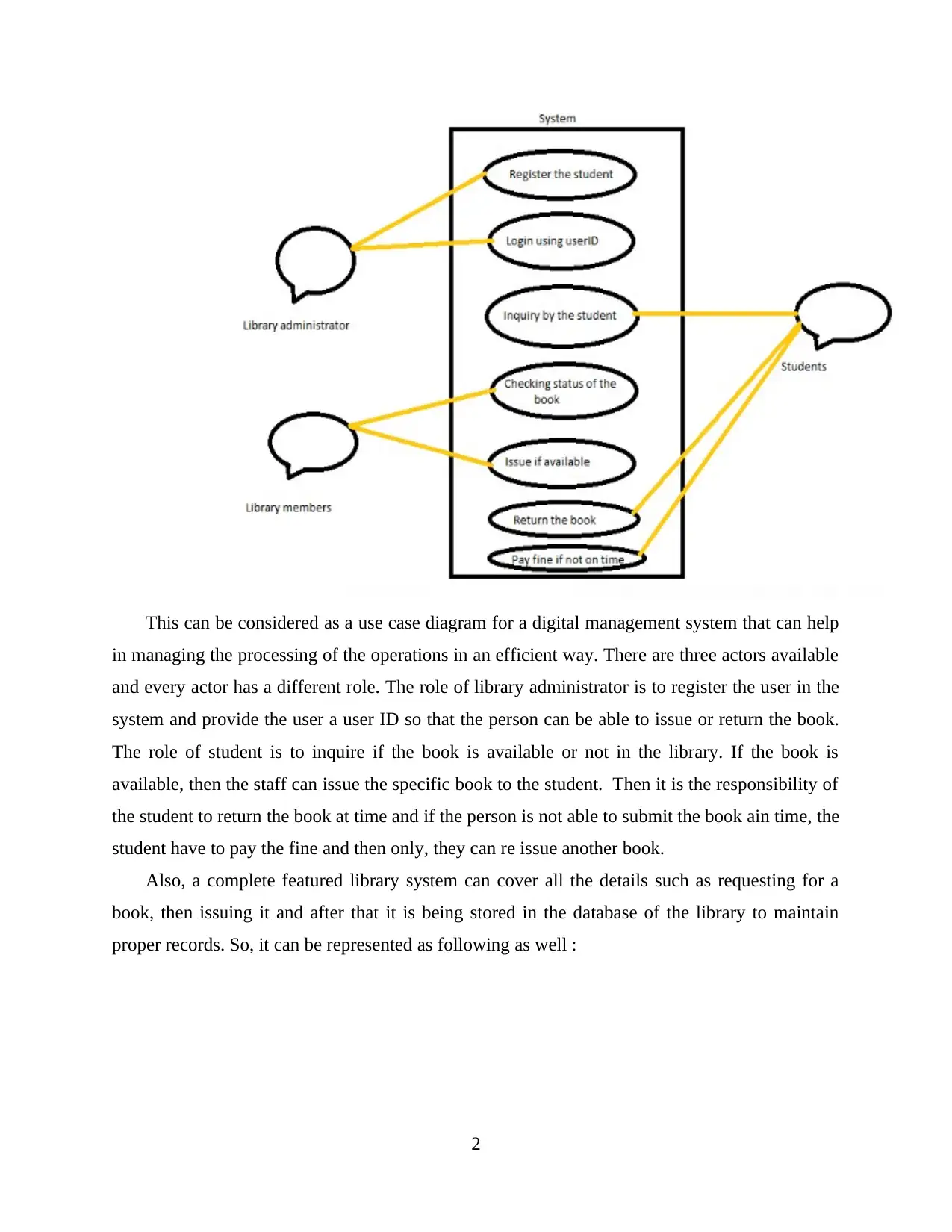
This can be considered as a use case diagram for a digital management system that can help
in managing the processing of the operations in an efficient way. There are three actors available
and every actor has a different role. The role of library administrator is to register the user in the
system and provide the user a user ID so that the person can be able to issue or return the book.
The role of student is to inquire if the book is available or not in the library. If the book is
available, then the staff can issue the specific book to the student. Then it is the responsibility of
the student to return the book at time and if the person is not able to submit the book ain time, the
student have to pay the fine and then only, they can re issue another book.
Also, a complete featured library system can cover all the details such as requesting for a
book, then issuing it and after that it is being stored in the database of the library to maintain
proper records. So, it can be represented as following as well :
2
in managing the processing of the operations in an efficient way. There are three actors available
and every actor has a different role. The role of library administrator is to register the user in the
system and provide the user a user ID so that the person can be able to issue or return the book.
The role of student is to inquire if the book is available or not in the library. If the book is
available, then the staff can issue the specific book to the student. Then it is the responsibility of
the student to return the book at time and if the person is not able to submit the book ain time, the
student have to pay the fine and then only, they can re issue another book.
Also, a complete featured library system can cover all the details such as requesting for a
book, then issuing it and after that it is being stored in the database of the library to maintain
proper records. So, it can be represented as following as well :
2
Paraphrase This Document
Need a fresh take? Get an instant paraphrase of this document with our AI Paraphraser
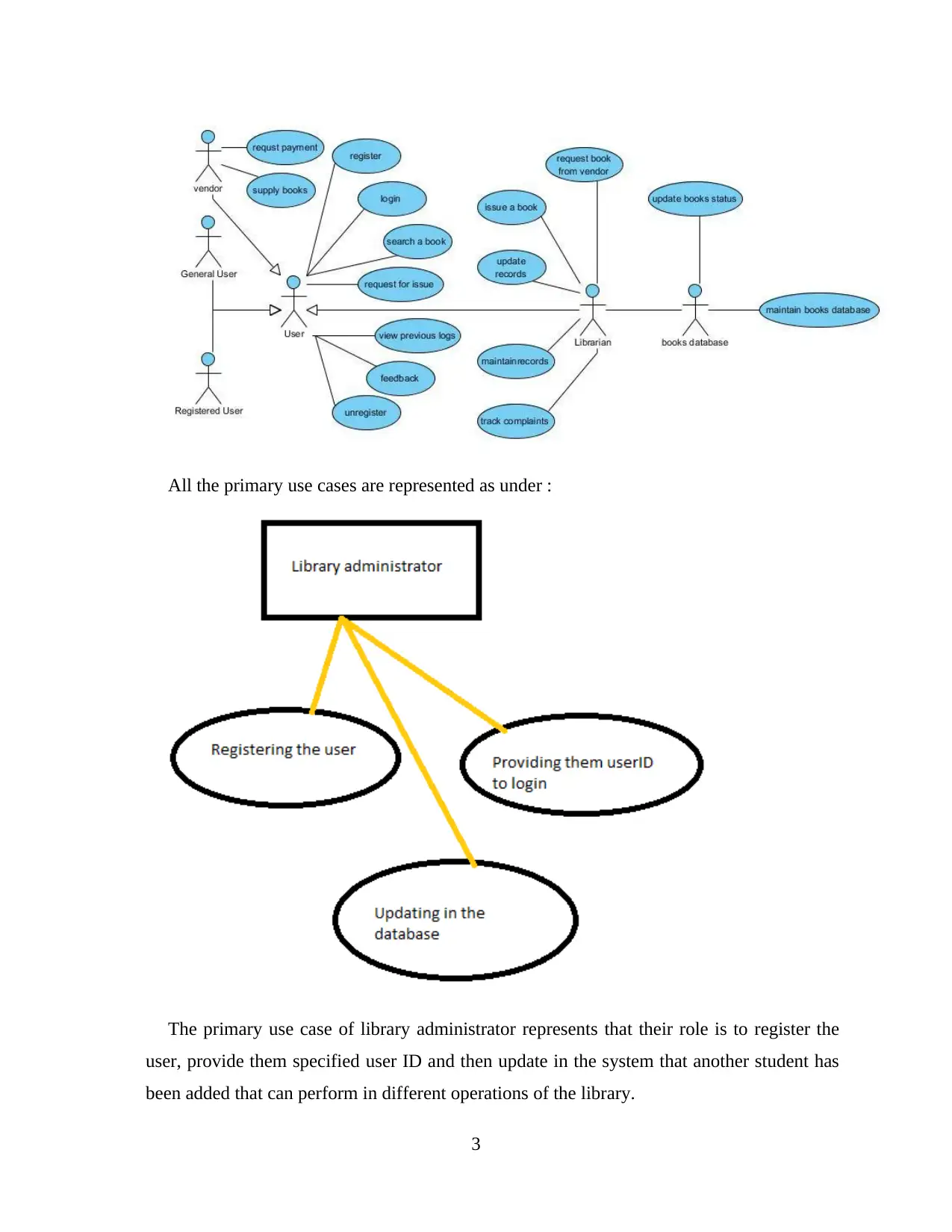
All the primary use cases are represented as under :
The primary use case of library administrator represents that their role is to register the
user, provide them specified user ID and then update in the system that another student has
been added that can perform in different operations of the library.
3
The primary use case of library administrator represents that their role is to register the
user, provide them specified user ID and then update in the system that another student has
been added that can perform in different operations of the library.
3
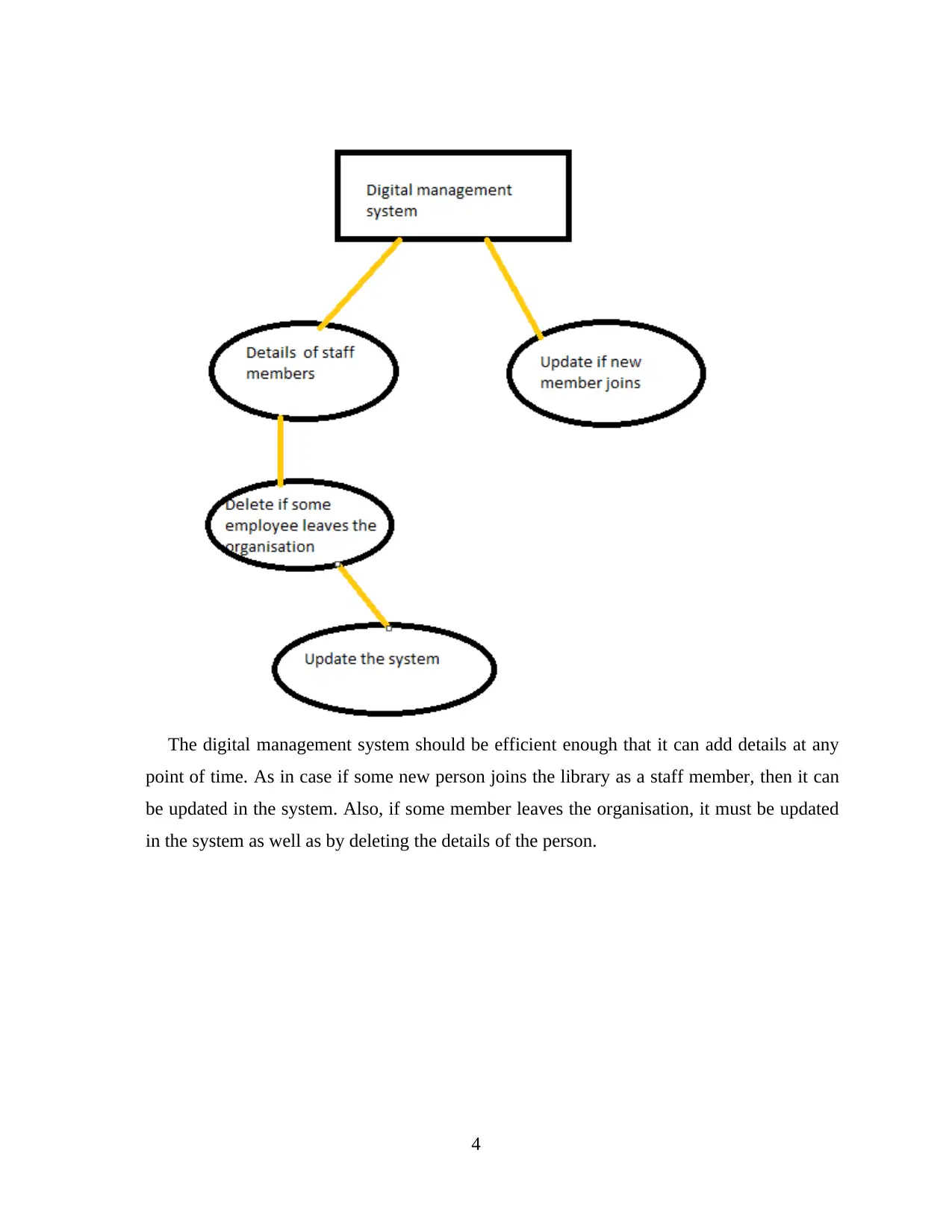
The digital management system should be efficient enough that it can add details at any
point of time. As in case if some new person joins the library as a staff member, then it can
be updated in the system. Also, if some member leaves the organisation, it must be updated
in the system as well as by deleting the details of the person.
4
point of time. As in case if some new person joins the library as a staff member, then it can
be updated in the system. Also, if some member leaves the organisation, it must be updated
in the system as well as by deleting the details of the person.
4
⊘ This is a preview!⊘
Do you want full access?
Subscribe today to unlock all pages.

Trusted by 1+ million students worldwide
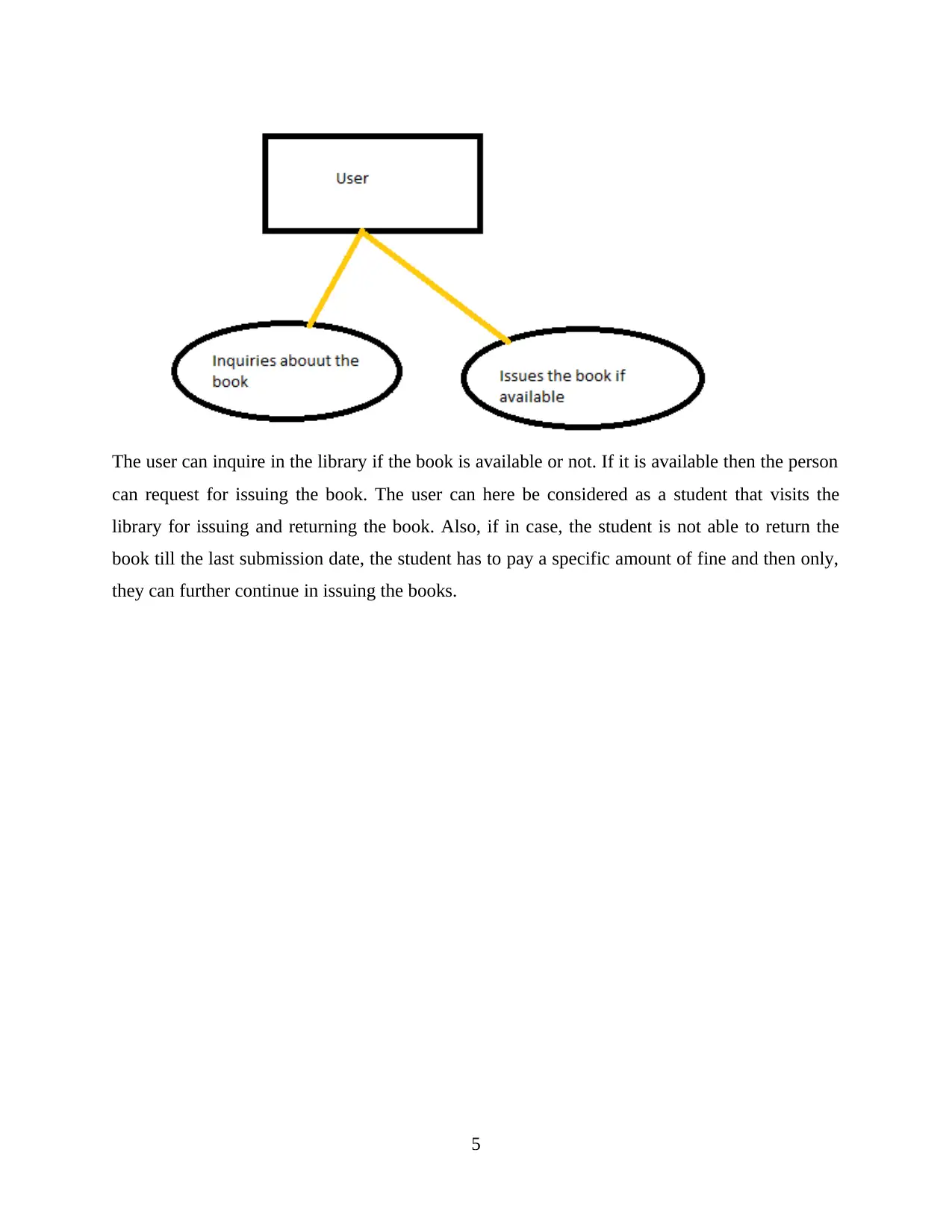
The user can inquire in the library if the book is available or not. If it is available then the person
can request for issuing the book. The user can here be considered as a student that visits the
library for issuing and returning the book. Also, if in case, the student is not able to return the
book till the last submission date, the student has to pay a specific amount of fine and then only,
they can further continue in issuing the books.
5
can request for issuing the book. The user can here be considered as a student that visits the
library for issuing and returning the book. Also, if in case, the student is not able to return the
book till the last submission date, the student has to pay a specific amount of fine and then only,
they can further continue in issuing the books.
5
Paraphrase This Document
Need a fresh take? Get an instant paraphrase of this document with our AI Paraphraser
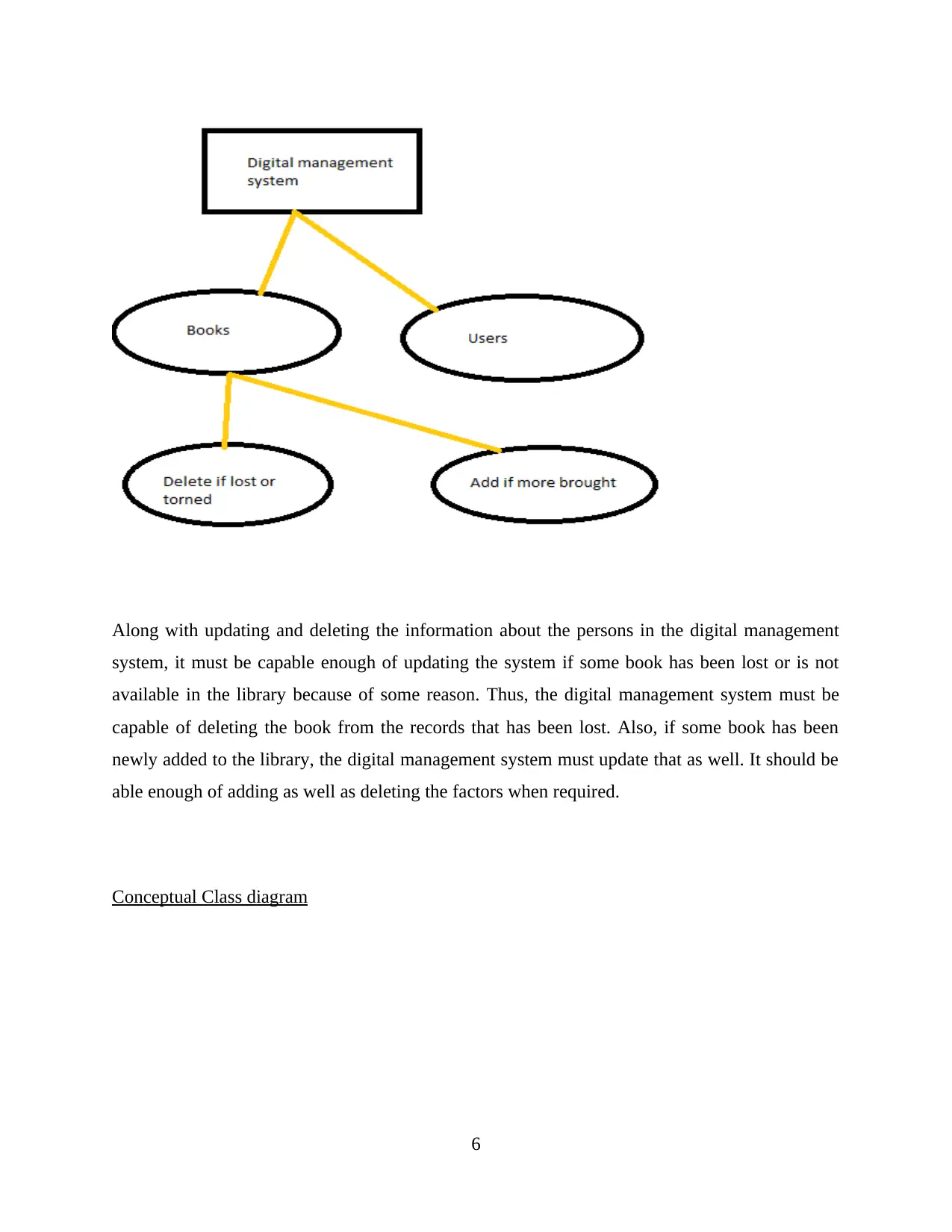
Along with updating and deleting the information about the persons in the digital management
system, it must be capable enough of updating the system if some book has been lost or is not
available in the library because of some reason. Thus, the digital management system must be
capable of deleting the book from the records that has been lost. Also, if some book has been
newly added to the library, the digital management system must update that as well. It should be
able enough of adding as well as deleting the factors when required.
Conceptual Class diagram
6
system, it must be capable enough of updating the system if some book has been lost or is not
available in the library because of some reason. Thus, the digital management system must be
capable of deleting the book from the records that has been lost. Also, if some book has been
newly added to the library, the digital management system must update that as well. It should be
able enough of adding as well as deleting the factors when required.
Conceptual Class diagram
6
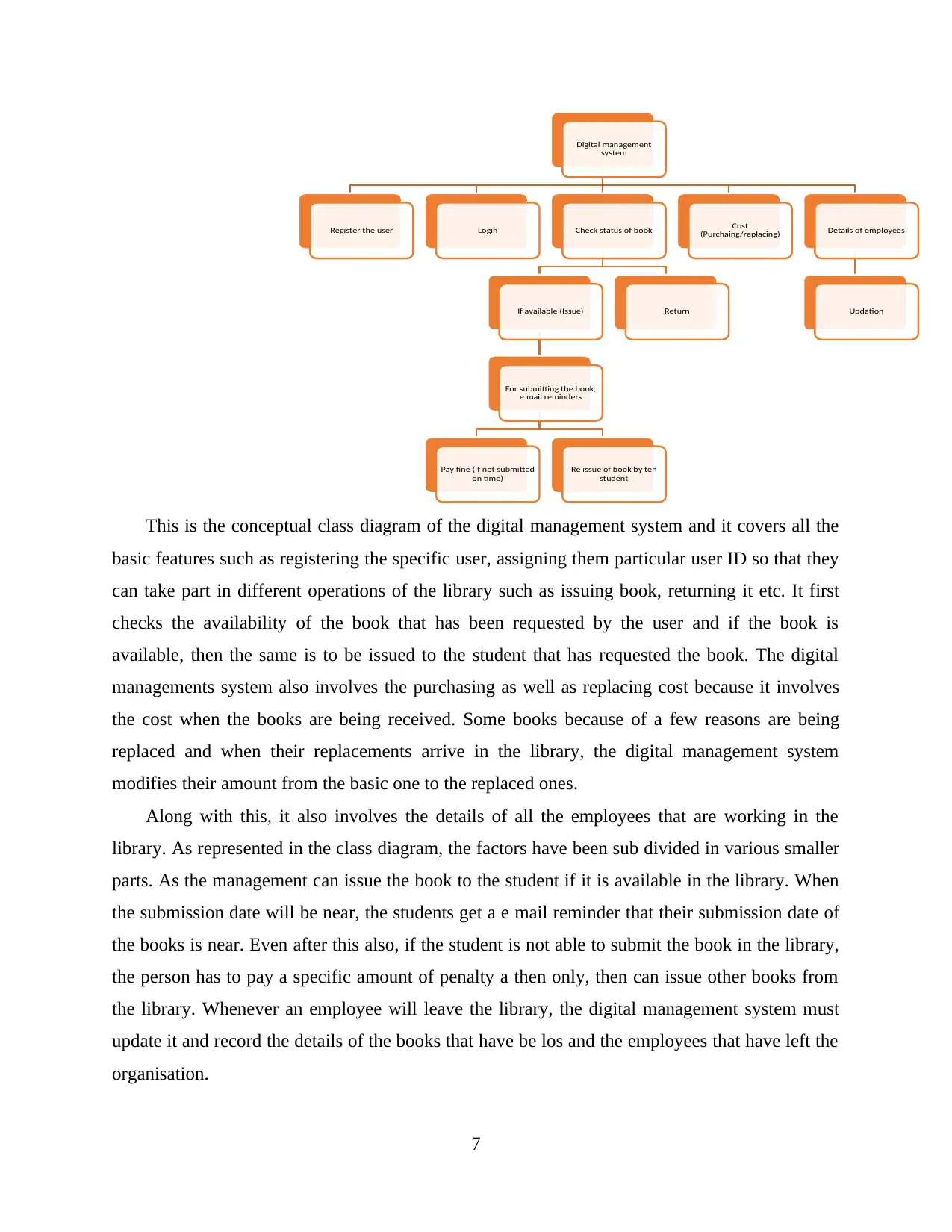
This is the conceptual class diagram of the digital management system and it covers all the
basic features such as registering the specific user, assigning them particular user ID so that they
can take part in different operations of the library such as issuing book, returning it etc. It first
checks the availability of the book that has been requested by the user and if the book is
available, then the same is to be issued to the student that has requested the book. The digital
managements system also involves the purchasing as well as replacing cost because it involves
the cost when the books are being received. Some books because of a few reasons are being
replaced and when their replacements arrive in the library, the digital management system
modifies their amount from the basic one to the replaced ones.
Along with this, it also involves the details of all the employees that are working in the
library. As represented in the class diagram, the factors have been sub divided in various smaller
parts. As the management can issue the book to the student if it is available in the library. When
the submission date will be near, the students get a e mail reminder that their submission date of
the books is near. Even after this also, if the student is not able to submit the book in the library,
the person has to pay a specific amount of penalty a then only, then can issue other books from
the library. Whenever an employee will leave the library, the digital management system must
update it and record the details of the books that have be los and the employees that have left the
organisation.
7
Digital management
system
Register the user Login Check status of book
If available (Issue)
For submitting the book,
e mail reminders
Pay fine (If not submitted
on time)
Re issue of book by teh
student
Return
Cost
(Purchaing/replacing) Details of employees
Updation
basic features such as registering the specific user, assigning them particular user ID so that they
can take part in different operations of the library such as issuing book, returning it etc. It first
checks the availability of the book that has been requested by the user and if the book is
available, then the same is to be issued to the student that has requested the book. The digital
managements system also involves the purchasing as well as replacing cost because it involves
the cost when the books are being received. Some books because of a few reasons are being
replaced and when their replacements arrive in the library, the digital management system
modifies their amount from the basic one to the replaced ones.
Along with this, it also involves the details of all the employees that are working in the
library. As represented in the class diagram, the factors have been sub divided in various smaller
parts. As the management can issue the book to the student if it is available in the library. When
the submission date will be near, the students get a e mail reminder that their submission date of
the books is near. Even after this also, if the student is not able to submit the book in the library,
the person has to pay a specific amount of penalty a then only, then can issue other books from
the library. Whenever an employee will leave the library, the digital management system must
update it and record the details of the books that have be los and the employees that have left the
organisation.
7
Digital management
system
Register the user Login Check status of book
If available (Issue)
For submitting the book,
e mail reminders
Pay fine (If not submitted
on time)
Re issue of book by teh
student
Return
Cost
(Purchaing/replacing) Details of employees
Updation
⊘ This is a preview!⊘
Do you want full access?
Subscribe today to unlock all pages.

Trusted by 1+ million students worldwide
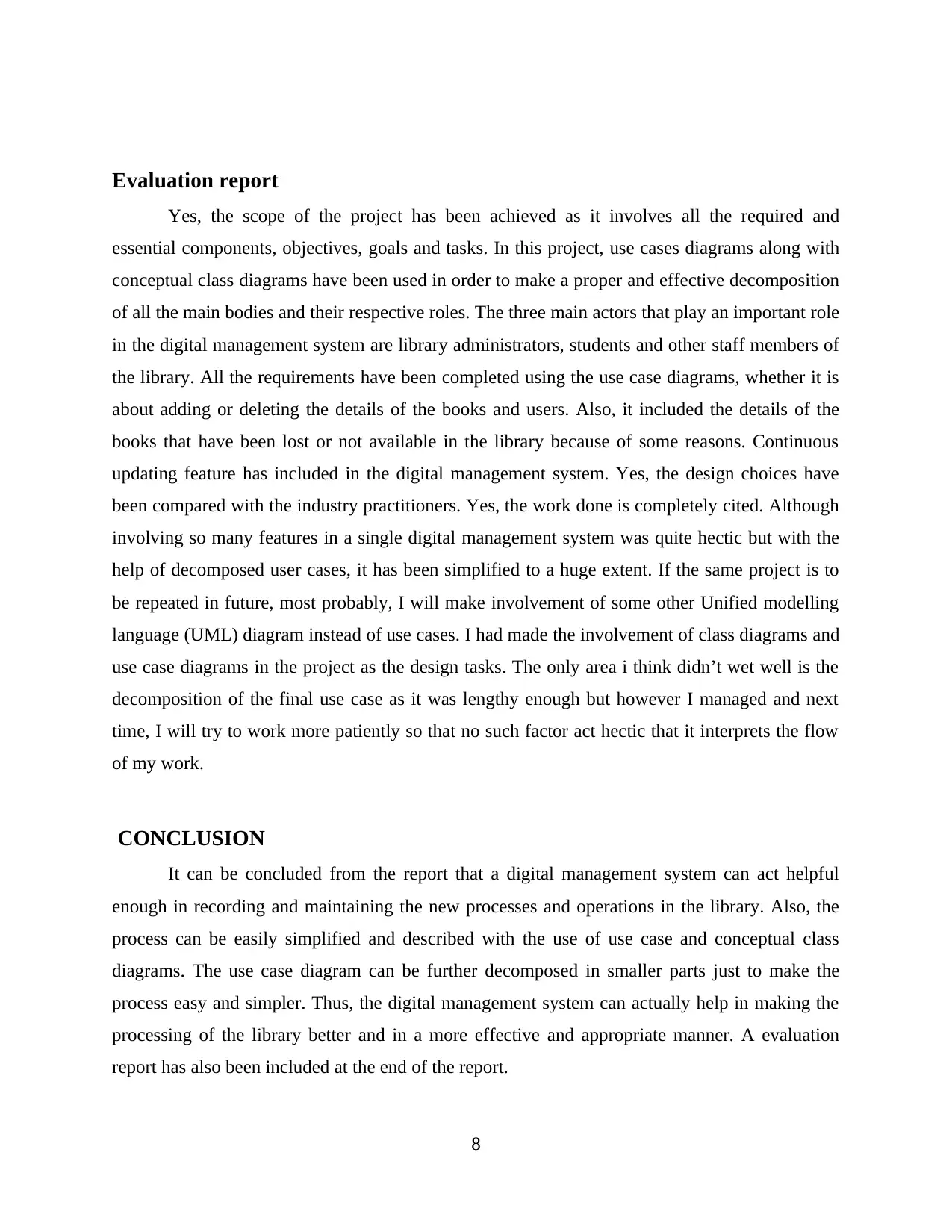
Evaluation report
Yes, the scope of the project has been achieved as it involves all the required and
essential components, objectives, goals and tasks. In this project, use cases diagrams along with
conceptual class diagrams have been used in order to make a proper and effective decomposition
of all the main bodies and their respective roles. The three main actors that play an important role
in the digital management system are library administrators, students and other staff members of
the library. All the requirements have been completed using the use case diagrams, whether it is
about adding or deleting the details of the books and users. Also, it included the details of the
books that have been lost or not available in the library because of some reasons. Continuous
updating feature has included in the digital management system. Yes, the design choices have
been compared with the industry practitioners. Yes, the work done is completely cited. Although
involving so many features in a single digital management system was quite hectic but with the
help of decomposed user cases, it has been simplified to a huge extent. If the same project is to
be repeated in future, most probably, I will make involvement of some other Unified modelling
language (UML) diagram instead of use cases. I had made the involvement of class diagrams and
use case diagrams in the project as the design tasks. The only area i think didn’t wet well is the
decomposition of the final use case as it was lengthy enough but however I managed and next
time, I will try to work more patiently so that no such factor act hectic that it interprets the flow
of my work.
CONCLUSION
It can be concluded from the report that a digital management system can act helpful
enough in recording and maintaining the new processes and operations in the library. Also, the
process can be easily simplified and described with the use of use case and conceptual class
diagrams. The use case diagram can be further decomposed in smaller parts just to make the
process easy and simpler. Thus, the digital management system can actually help in making the
processing of the library better and in a more effective and appropriate manner. A evaluation
report has also been included at the end of the report.
8
Yes, the scope of the project has been achieved as it involves all the required and
essential components, objectives, goals and tasks. In this project, use cases diagrams along with
conceptual class diagrams have been used in order to make a proper and effective decomposition
of all the main bodies and their respective roles. The three main actors that play an important role
in the digital management system are library administrators, students and other staff members of
the library. All the requirements have been completed using the use case diagrams, whether it is
about adding or deleting the details of the books and users. Also, it included the details of the
books that have been lost or not available in the library because of some reasons. Continuous
updating feature has included in the digital management system. Yes, the design choices have
been compared with the industry practitioners. Yes, the work done is completely cited. Although
involving so many features in a single digital management system was quite hectic but with the
help of decomposed user cases, it has been simplified to a huge extent. If the same project is to
be repeated in future, most probably, I will make involvement of some other Unified modelling
language (UML) diagram instead of use cases. I had made the involvement of class diagrams and
use case diagrams in the project as the design tasks. The only area i think didn’t wet well is the
decomposition of the final use case as it was lengthy enough but however I managed and next
time, I will try to work more patiently so that no such factor act hectic that it interprets the flow
of my work.
CONCLUSION
It can be concluded from the report that a digital management system can act helpful
enough in recording and maintaining the new processes and operations in the library. Also, the
process can be easily simplified and described with the use of use case and conceptual class
diagrams. The use case diagram can be further decomposed in smaller parts just to make the
process easy and simpler. Thus, the digital management system can actually help in making the
processing of the library better and in a more effective and appropriate manner. A evaluation
report has also been included at the end of the report.
8
Paraphrase This Document
Need a fresh take? Get an instant paraphrase of this document with our AI Paraphraser
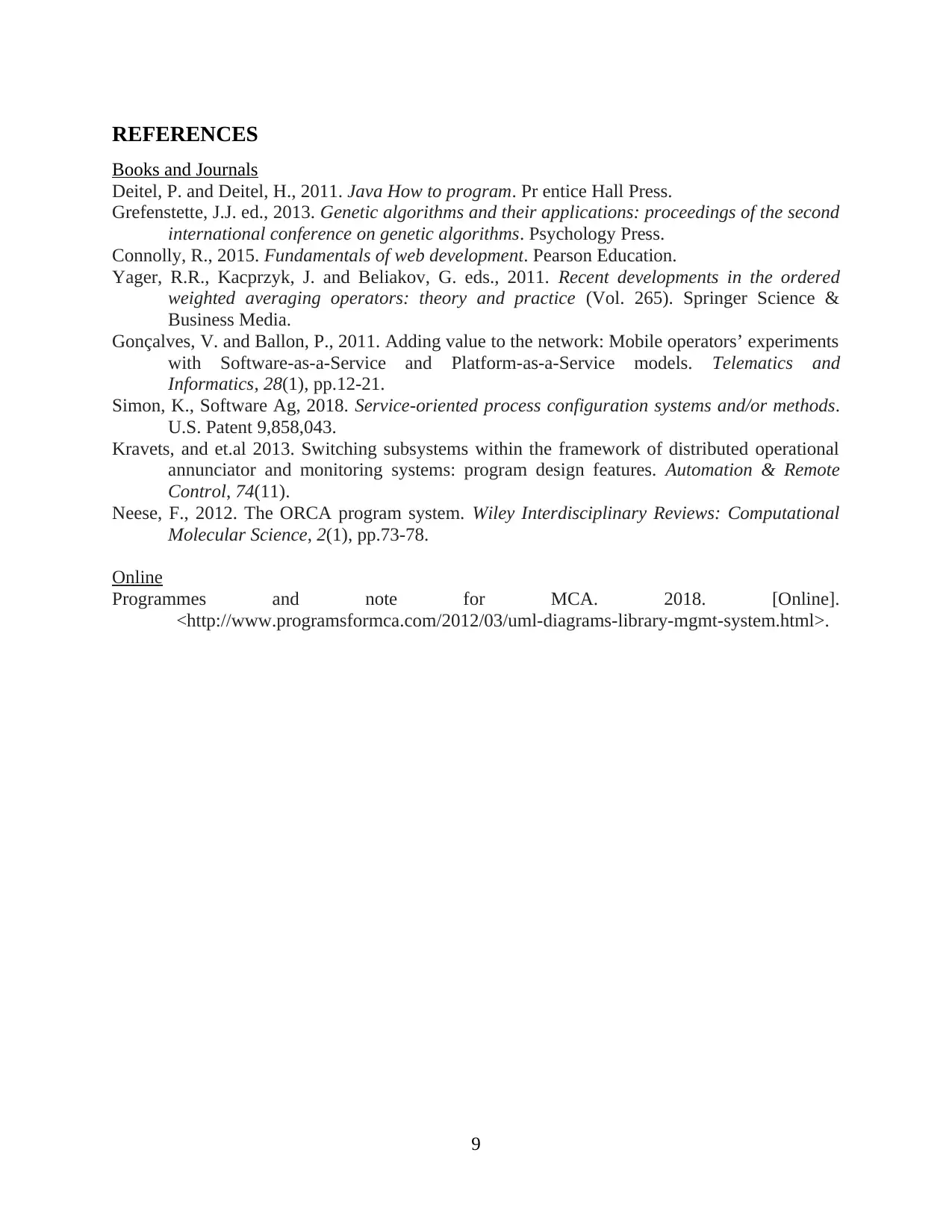
REFERENCES
Books and Journals
Deitel, P. and Deitel, H., 2011. Java How to program. Pr entice Hall Press.
Grefenstette, J.J. ed., 2013. Genetic algorithms and their applications: proceedings of the second
international conference on genetic algorithms. Psychology Press.
Connolly, R., 2015. Fundamentals of web development. Pearson Education.
Yager, R.R., Kacprzyk, J. and Beliakov, G. eds., 2011. Recent developments in the ordered
weighted averaging operators: theory and practice (Vol. 265). Springer Science &
Business Media.
Gonçalves, V. and Ballon, P., 2011. Adding value to the network: Mobile operators’ experiments
with Software-as-a-Service and Platform-as-a-Service models. Telematics and
Informatics, 28(1), pp.12-21.
Simon, K., Software Ag, 2018. Service-oriented process configuration systems and/or methods.
U.S. Patent 9,858,043.
Kravets, and et.al 2013. Switching subsystems within the framework of distributed operational
annunciator and monitoring systems: program design features. Automation & Remote
Control, 74(11).
Neese, F., 2012. The ORCA program system. Wiley Interdisciplinary Reviews: Computational
Molecular Science, 2(1), pp.73-78.
Online
Programmes and note for MCA. 2018. [Online].
<http://www.programsformca.com/2012/03/uml-diagrams-library-mgmt-system.html>.
9
Books and Journals
Deitel, P. and Deitel, H., 2011. Java How to program. Pr entice Hall Press.
Grefenstette, J.J. ed., 2013. Genetic algorithms and their applications: proceedings of the second
international conference on genetic algorithms. Psychology Press.
Connolly, R., 2015. Fundamentals of web development. Pearson Education.
Yager, R.R., Kacprzyk, J. and Beliakov, G. eds., 2011. Recent developments in the ordered
weighted averaging operators: theory and practice (Vol. 265). Springer Science &
Business Media.
Gonçalves, V. and Ballon, P., 2011. Adding value to the network: Mobile operators’ experiments
with Software-as-a-Service and Platform-as-a-Service models. Telematics and
Informatics, 28(1), pp.12-21.
Simon, K., Software Ag, 2018. Service-oriented process configuration systems and/or methods.
U.S. Patent 9,858,043.
Kravets, and et.al 2013. Switching subsystems within the framework of distributed operational
annunciator and monitoring systems: program design features. Automation & Remote
Control, 74(11).
Neese, F., 2012. The ORCA program system. Wiley Interdisciplinary Reviews: Computational
Molecular Science, 2(1), pp.73-78.
Online
Programmes and note for MCA. 2018. [Online].
<http://www.programsformca.com/2012/03/uml-diagrams-library-mgmt-system.html>.
9

10
⊘ This is a preview!⊘
Do you want full access?
Subscribe today to unlock all pages.

Trusted by 1+ million students worldwide
1 out of 12
Related Documents
Your All-in-One AI-Powered Toolkit for Academic Success.
+13062052269
info@desklib.com
Available 24*7 on WhatsApp / Email
![[object Object]](/_next/static/media/star-bottom.7253800d.svg)
Unlock your academic potential
Copyright © 2020–2025 A2Z Services. All Rights Reserved. Developed and managed by ZUCOL.




